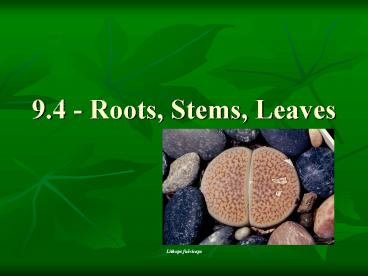9'4 Roots, Stems, Leaves - PowerPoint PPT Presentation
1 / 20
Title:
9'4 Roots, Stems, Leaves
Description:
1. Apical Meristem. At tips. Responsible for primary growth. Growth through elongation ... apical meristem. Zone of cell division is where the apical meristem ... – PowerPoint PPT presentation
Number of Views:83
Avg rating:3.0/5.0
Title: 9'4 Roots, Stems, Leaves
1
9.4 - Roots, Stems, Leaves
Lithops fulviceps
2
I. Plant Tissue Groups
- A. Ground Tissues
- Three Main Types of Cells (can also be associated
with other tissues) - 1. Parenchyma
- Generally unspecialized
- Thin walls
- Lots of functions (storage, photosynthesis, etc)
- 2. Collenchyma
- Thick yet flexible walls
- Primarily for support of new plant parts
3
I. Plant Tissue Groups
- A. Ground Tissue (cont.)
- 3. Sclerenchyma
- Thicker than collenchyma
- Support
- Secondary wall with lignin
- May be dead
- B. Dermal Tissue
- Contains epidermis, guard cells, and specialized
surface tissues (e.g. root hairs) - Dermal tissue excretes cuticle
4
I. Plant Tissue Groups
- C. Vascular Tissue
- Xylem and Phloem
- Occur in vascular bundles (including sclerenchyma
cells) - 1. Xylem
- Conduct water and minerals up plant
- Secondary cell wall provides strength
- Normally dead
- Two types of cells
- Tracheids - water passes through pits in
secondary wall - Vessel elements - holes go through both primary
and secondary walls
5
Xylem Structure
6
I. Plant Tissue Groups
- C. Vascular Tissue (cont.)
- 2. Phloem
- Normally alive (still contains cytoplasm)
- Made up of sieve tubes (connected by sieve plates)
7
(No Transcript)
8
II. Plant Growth Overview
- A. Life span
- Annual - born, live and love, die all in one year
(whew!) - Biennial - Two years
- Perennial - Just keep on livin
9
II. Plant Growth Overview
- B. Meristems
- 1. Apical Meristem
- At tips
- Responsible for primary growth
- Growth through elongation
- 2. Lateral Meristems
- Lateral growth (makes you wider)
- Produces secondary growth
- Secondary tissue are thicker/tougher
- Wood is secondary xylem, bark is secondary dermal
tissue
10
III. Roots
- A. Organization
- Root cap protects the apical meristem
- Zone of cell division is where the apical
meristem resides - Zone of maturation forms root hairs
- Zone of elongation makes new root
- B. Cortex
- Main part of root
- Stores water, minerals, and starch
11
III. Roots
- C. Endodermis
- Ring of cells that separate cortex from vascular
tissue (or stele) - Innermost layer of cortex
- D. Vascular Cylinder (Stele)
- Inside the endodermis
- Organization is different in monocots and dicots
12
Root Structure
13
IV. Stems
- Similar to roots, but lack an endodermis and
- A. Epidermis
- Cells secrete cuticle, do not make hairs
- B. Cortex
- More evenly distributed
- C. Vascular Bundles
- More spread out than the roots
- In dicots, vascular bundles are organized in ring
(pith inside of the ring) - In monocots, vascular bundles are randomly
distributed
14
Stem Structure (Primary)
15
IV. Stems
- D. Secondary Growth
- Vascular cambium (lateral meristem) forms between
xylem and phloem - Form the wood of woody plants
- Growth goes both ways from cambium
- Outer part of cambium becomes bark (along with
phloem) - See why we can tap a maple tree for sugar
16
Stem Structure (Secondary Growth)
17
V. Leaves
- A. Epidermis
- Protective covering
- Make cuticle
- prevents transpiration
- Made of waxes and cutin
- Provide protection from microorganisms
- Lower epidermis has guard cells which surround
stomata - B. Palisades Layer
- Part of mesophyll
- Made up mostly of tightly packed parenchyma cells
that undergo photosynthesis - More pronounced in dicots
18
V. Leaves
- C. Spongy Layer
- Made of loosely packed parenchyma cells
- Area of gas exchange
- D. Vascular Bundles
- Contain xylem and phloem
- Surrounded by bundle sheath cells
- Bundle sheath cells prevent gas bubble from
blocking vascular tissue
19
Leaf Structure
20
Monocots Vs. Dicots































